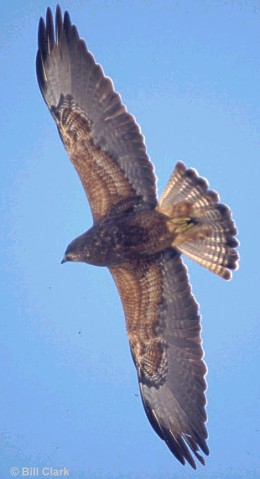|
|
|
SWAINSON'S
HAWK (Buteo
swainsoni) |
Description:
The Swainson's Hawk is a medium-sized raptor of western North America,
with a length of ~50 cm and an average weight ranging from around 800
grams for males to around 1100 grams for females.
Adults
are quite uniformly dark above, and usually have a dark breast
band. The underparts can be quite variable, ranging from
mostly white to almost entirely dark. In flight, they can be
recognized by their pointed wingtips, and a distinct contrast in colour between the paler wing
lining and the darker primaries and secondaries. The tail is
marked with several fine dark bands, with a broader terminal band.
As
in most raptors, females are somewhat larger than males, but there
are no reliable differences in plumage. Juveniles tend to be
paler than adults, especially on the back and head.
Similar
species:
Closest to the Swainson's Hawk in size and shape is the
Red-tailed Hawk. The dark band on a Red-tailed Hawk is usually
lower (on the belly), and the back is not as dark; in flight
especially the tail is an excellent field mark to distinguish
between the two species. Other North American buteos
(especially Rough-legged, Ferruginous, Red-shouldered, and
Broad-winged Hawks) may occasionally be mistaken for Swainson's, but
can be reliably separated by experienced observers.
|

|
Habitat:
The Swainson's Hawk is primarily a grassland species. Most of
the North American breeding range is in the plains of the western states
and prairie provinces, though there are also a few isolated populations in
the northwest where they inhabit tundra instead of grasslands. In
winter, the majority of the population is found in the pastures and
natural grasslands of the Argentinian plains, though a small number
overwinter in south Florida, where they occupy agricultural lands and
other open areas.
Range:
The main breeding range of the Swainson's Hawk extends from northern
Mexico in the south to central Alberta and Saskatchewan in the north, and
from roughly the 100th Meridian in the east to within a couple of hundred
kilometres of the Pacific Ocean in the west. Isolated breeding
populations are also known in northeast Alaska, southwest Yukon Territory,
and northwest Northwest Territories. The main migratory route goes
through Central America and along the east side of the Andes to northern
Argentina.
Behaviour:
The Swainson's Hawk is territorial during the breeding season, but
otherwise quite gregarious, with wintering flocks numbering in the
hundreds or even thousands. They are frequently observed on elevated
perches, including fence posts, utility poles and wires, and live or dead
trees. In open areas lacking perches, they will often perch on the
ground, typically selecting slightly elevated areas with sparse
vegetation.
Diet:
The Swainson's Hawk's diet in summer is primarily small mammals, but
in winter is almost exclusively grasshoppers. They hunt either from
perches, or from the air.
Conservation
issues:
Recent population estimates have been based largely on the migration
counts at Veracruz, Mexico, past which the majority of Swainson's Hawks
are believed to fly each fall. In recent years over one
million individuals have been counted per season, suggesting that the North American
population is at least this large on average. Though still very
numerous, the population is thought to have declined considerably over the
years, as the range formerly extended further east and west.
Pesticide
induced mortality on the wintering grounds was a serious issue in the
mid-1990s. Beginning in the late 1980s, monocrotophos, a toxic
organophosphate, was widely used in Argentina to control grasshopper
populations in agricultural areas. In the winters of 1994-95 and
1995-96, over 24,000 dead Swainson's Hawks were found to be victims of
monocrotophos poisoning. Researchers were quick to identify the
cause of mortality, and the Argentinian government responded by banning
the use of monocrotophos. No related deaths have been reported since
the winter of 1998-99, and the population appears not to have suffered any
long-term decline, thanks to the quick actions by all parties.
Recommended
references:
Clark, W.S., and B.K. Wheeler. 2001. A Field Guide to Hawks of
North America. Revised. Peterson Field Guide Series, No.
35. Houghton Mifflin, Boston.
England, A.S., M.J. Bechard, and C.S. Houston. 1997.
Swainson's Hawk (Buteo swainsoni). In The Birds of
North America, No. 265 (A. Poole and F. Gill, eds.). Academy of
Natural Sciences, Philadelphia PA, and American Ornithologists Union,
Washington DC.
Goldstein,
M.I., T.E. Lacher Jr, B. Woodbridge, M.J. Bechard, S.B. Canavelli, M.E.
Zaccagnini, G.P. Cobb, E.J. Scollon, R. Tribolet, and M.J. Hooper.
1999. Monocrotophos-induced mass mortality of Swainson's hawks in
Argentina, 1995-96. Ecotoxicology 8: 201-214.
Johnsgard,
P.A. 1990. Hawks, eagles, and falcons of North America:
biology and natural history. Smithsonian Institution Press, Washington DC, USA, pp
221-226.
|

